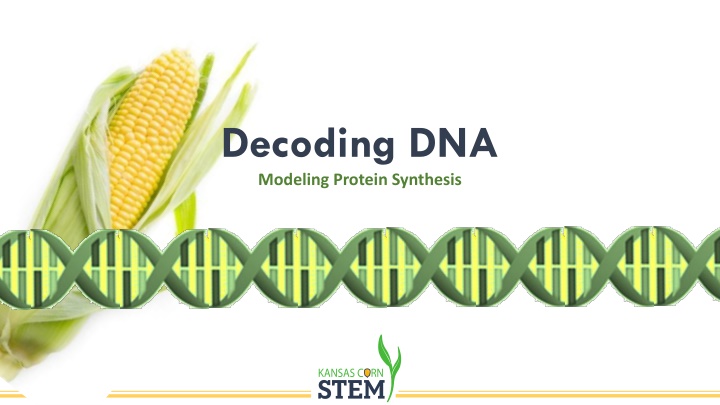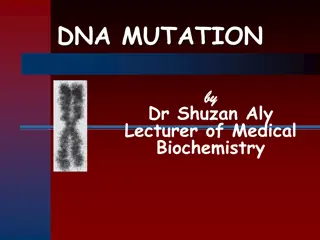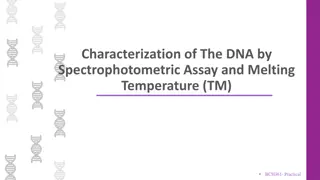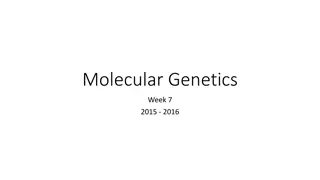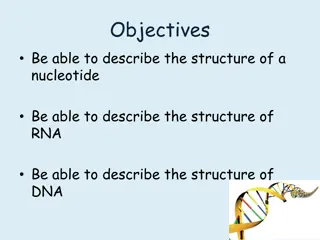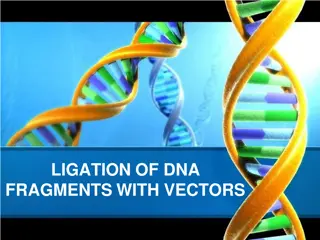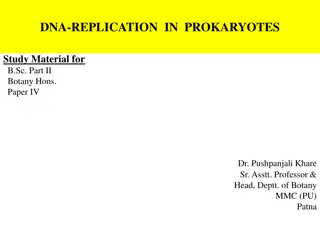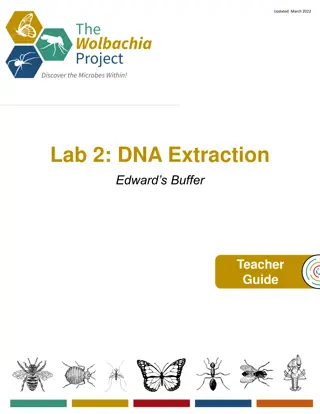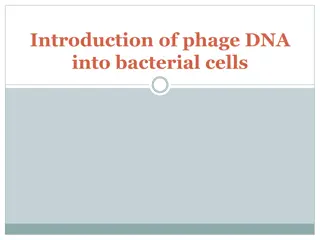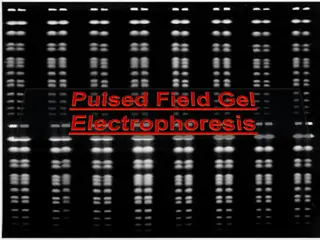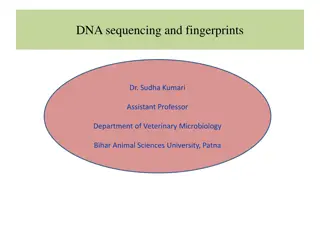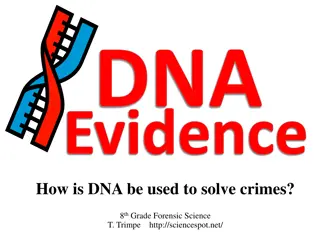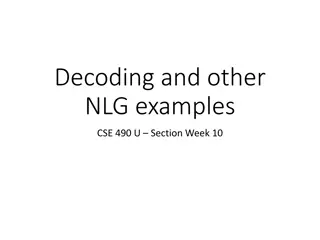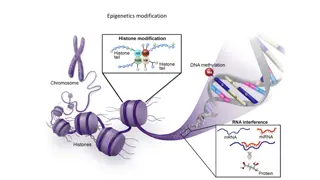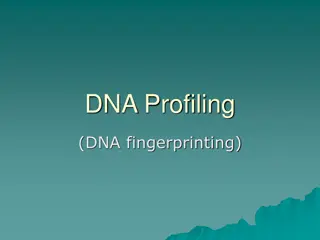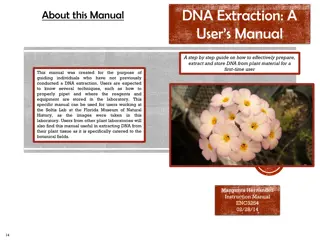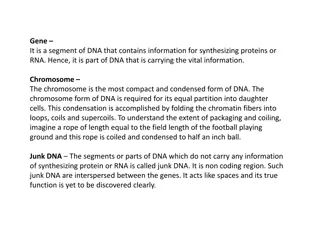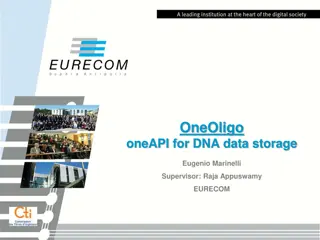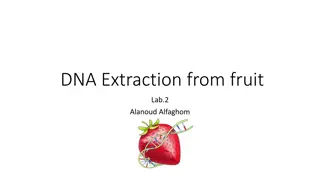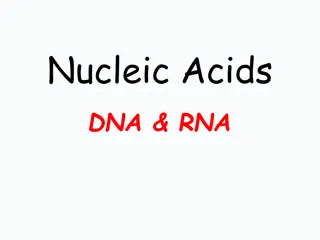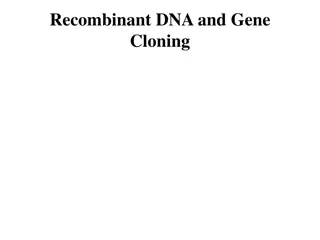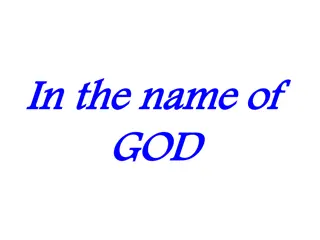Decoding DNA
In this lab, students will model the intricate process of protein synthesis by analyzing the genetic code and converting it into a protein through transcription and translation. The purpose, desired learning outcomes, materials needed, setup instructions, and curriculum incorporation are detailed to facilitate a hands-on learning experience. Students will explore the role of DNA as the storage molecule for genetic information and practice transcription, translation, and reverse coding processes.
Download Presentation

Please find below an Image/Link to download the presentation.
The content on the website is provided AS IS for your information and personal use only. It may not be sold, licensed, or shared on other websites without obtaining consent from the author.If you encounter any issues during the download, it is possible that the publisher has removed the file from their server.
You are allowed to download the files provided on this website for personal or commercial use, subject to the condition that they are used lawfully. All files are the property of their respective owners.
The content on the website is provided AS IS for your information and personal use only. It may not be sold, licensed, or shared on other websites without obtaining consent from the author.
E N D
Presentation Transcript
Decoding DNA Modeling Protein Synthesis
All handouts for the lab can be found in your notebook- -Blue Tabs pages S10-S12 -online at www.kscorn.com
Purpose of this lab: The purpose of this lab it to model the intricate process of protein synthesis that is detailed in the DNA by analyzing the genetic code and converting that into a protein through the processes of transcription and translation.
Desired learning outcomes: Students will model that DNA is the storage molecule for genetic information in the cell Students will perform transcription of DNA molecules into mRNA Students will translate the mRNA molecules into sentences that represent proteins Students will reverse the process to code a DNA molecule that will produce a given sentence
How to incorporate into your curriculum: Genetics unit GMO s
Materials Needed: DNA Sentence Strips High School (pg. S1-2) DNA Sentence Strips Middle School (pg. S3-4) tRNA cards; 1 set for each group (pg. S6-9) Blank strips to transcribe mRNA; 1 for each sentence to be transcribed (pg. S5) Decoding DNA Student Handout (pg. S10-12) Decoding DNA PowerPoint 3D printed ribosome model (stl file is available online) (all of these are available online at kscorn.com) Model of DNA A hula hoop to represent the nucleus of the cell
Set up: Make sure each group receives a complete set of tRNA cards a blank strip (mRNA) for each sentence they will transcribe a student recording sheet a blank strip to record their engineered DNA to return to the nucleus
Set up: Arrange the room into groups. Print and cut the DNA sentence strips for the grade level you are working with (middle school or high school) Designate a table in a central location the nucleus (hula hoop) that will be the location of the DNA strips. DNA strips must not leave the nucleus. One student from each group will go the nucleus and transcribe a sentence that their group has not yet decoded.
Set up: Print tRNA cards, each group will need a complete set, cut these out before hand. It is helpful if each page of cards are printed on a different color
Classroom Set up: Group 1 Group 2 Nucleus Nucleus Group 3 Group 4 Group 5 Group 6
Decoding DNA Modeling Protein Synthesis
Introduction I often start by showing a short video clip to get their attention: Overview of transcription and translation https://youtu.be/h3b9ArupXZg HHMI DNA transcription https://www.youtube.com/watch?v=8M198uHJd_8 HHMI DNA Translation https://www.youtube.com/watch?v=ZNl1z6Lev1E
A T A C G T A C G A T C G A T C G A T A T G C A T G C T A G C T A G C T DNA carries the genetic instructions for an organism. It is a polymer of four different nucleotides: A, T, C and G. It is arranged in long chains that form a double helix. On each side of the helix is a complementary nucleotide. A pairs with T C pairs with G End of Slide
Transcription: DNA to mRNA RNA polymerase mRNA DNA cannot leave the cell s nucleus RNA polymerase copies DNA to make mRNA Notice that in RNA, A codes for U instead of T. mRNA is a working copy of the DNA that carries DNA s message. End of Slide
Start Codon Translation: mRNA to Protein mRNA mRNA is read in 3 base (letter) sequences called codons. AUG is the Start Codon . After the start codon; each 3 letter sequence is another codon. Each codon codes for one amino acid in the protein. End of Slide
Translation: mRNA to Protein Amino Acid MET MET tRNA is a molecule that translates mRNA into amino acids. On one end of tRNA there is a 3 letter sequence called an anticodon. On the other end tRNA carries an amino acid. tRNA Anticodon U A C U A C End of Slide
Translation: mRNA to Protein HIS MET The process of translation is carried out by a ribosome. The ribosome can hold two pieces of tRNA at a time. When two tRNA molecules are held in a ribosome, their amino acids bond together, forming a protein. U A C GU A Ribosome End of Slide
Translation: Initiation A C A matching tRNA attaches to the AUG start codon. The ribosome attaches to the mRNA where it finds this tRNA attached. End of Slide
Translation: Elongation MET A matching tRNA attaches to the next codon. A bond forms between the amino acids U A C End of Slide
CGA Translation: Elongation HIS MET GU A U A C End of Slide
UCG Translation: Elongation HIS ALA MET GU A CGA End of Slide
Translation: Termination HIS ALA MET SER A stop codon, UAG codes for a tRNA that releases the protein. UCG CGA End of Slide
Translation: Termination HIS STOP ALA SER MET Protein UCG AUC End of Slide
Lab Procedure: Transcription Each group will send one member to the nucleus to pick a DNA strand to transcribe in mRNA. Record the number of the DNA strand as well. Remember DNA has to stay in the nucleus. Gene #1 TAC AGT CCG TAG TGA ATT 1 A U G UCA GGC AUC ACU UAA mRNA # __ End of Slide
Lab Procedure: Translation Leaving the DNA in the nucleus, return to group with mRNA. Working as a group scan mRNA for first AUG (Start Codon) and highlight. Make a mark every three letters after to divide remaining codons. 1 A U G UCA GGC AUC ACU UAA mRNA # __ End of Slide
Lab Procedure: Translation Find the tRNA card with the UAC anticodon and match it with the start codon. (Start) UAC 1 A U G UCA GGC AUC ACU UAA mRNA # __ End of Slide
Lab Procedure: Translation Record the number of the mRNA strand in blank after the sentence #. (Start) UAC 1 A U G UCA GGC AUC ACU UAA mRNA # __ Sentence # 1 End of Slide
Lab Procedure: Translation Find the tRNA card with the anticodon that matches the next codon. Ethanol (Start) UAC AGU 1 A U G UCA GGC AUC ACU UAA mRNA # __ Sentence # 1 End of Slide
Lab Procedure: Translation Write the words that are on the cards to complete a sentence. ethanol (Start) AGU UAC 1 A U G UCA GGC AUC ACU UAA mRNA # __ Sentence # 1Ethanol . End of Slide
Lab Procedure: Translation Write the words that are on the cards to complete a sentence. LESS/DECREASES /DECREASING ETHANOL Produces/Production . (Start) CO2 AGU CCG UAC UAG UGA AUU 1 A U G UCA GGC AUC ACU UAA mRNA # __ Sentence # 1Ethanol decreases CO2 production . . End of Slide
Translation Continue matching anticodons with codons until the sentence is complete. Each sentence should end with a period which represents the stop codon. Another group member will go to the nucleus and transcribe a different DNA strand to be translated by the group. Continue until your group has completed 4 sentences. Have your teacher check your sentences, and correct any mistakes. End of Slide
Genetic Engineering Ask your teacher for a sentence (protein) that would benefit the organism. The sequence of DNA is important. Sentence End of Slide
Genetic Engineering In your group find the cards (tRNA) that would produce the sentence. Don t forget the start or punctuation cards. The sequence of DNA is important. (Start) the sequence of Sentence . is DNA important UAC AAA UUA GUA UGA CUA UUU AAU End of Slide
Genetic Engineering Write the mRNA strand that would code for this sequence of tRNA. (Start) important . sequence of DNA is the UAC CUA UGA UUA AAA GUA AAU UUU mRNA AUGCAUGAUACUAAUUUUUUAAAA End of Slide
Reverse Transcription Write the DNA strand that would code for the mRNA. Remember this is DNA so A codes for T. mRNA AUGCAUGAUACUAAUUUUUUAAAA TACGTACTATGATTAAAAAATTTT DNA End of Slide
Genetic Engineering Have your teacher check your DNA strand. If it is correct, place your DNA strand in the nucleus. Don t forget Start and stop codons. End of Slide
Genetically engineer the sentence: Biotechnology can increase our quality of life.
Reflection and Conclusion: How are chromosomes, DNA, genes, and proteins related? What area of the cell does the table/hula hoop holding DNA represent in this modeling activity? Why can the DNA strand not be brought back to your group? What area of the cell does your table represent? What do the words represent? The completed sentences? What do you think the consequences might be if an error occurred in the cell as it goes through the process of protein synthesis?
Budget This lab is made possible with the support and content contributions of the Kansas Corn Commission.
